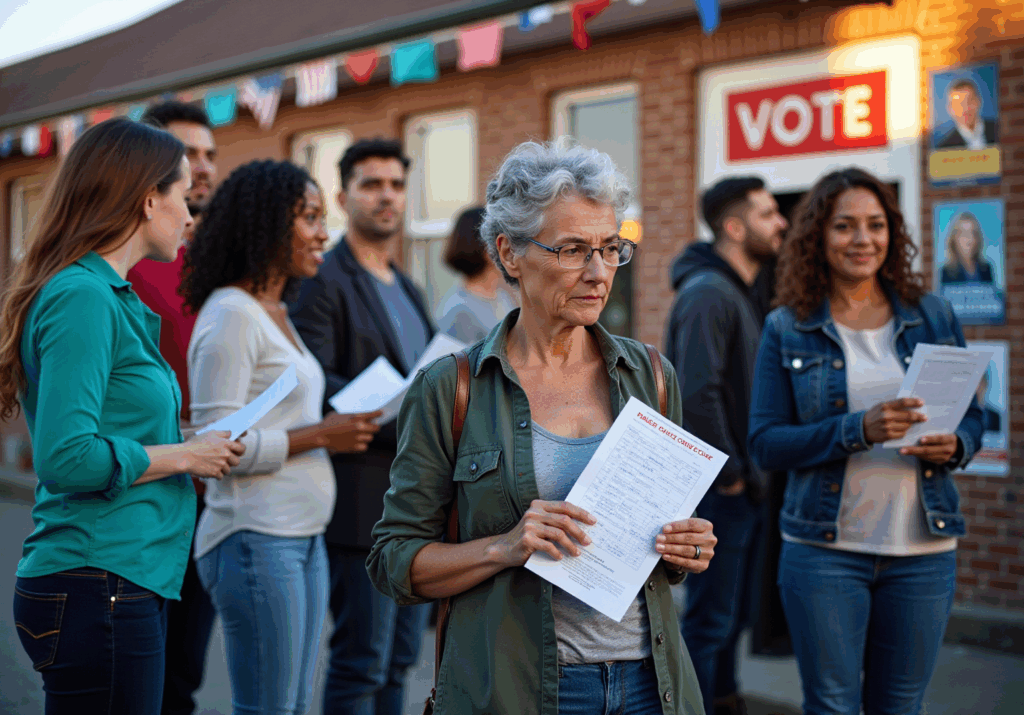Overview
Ranked voting, or ranked choice voting (RCV), represents a transformative electoral system that empowers voters to rank candidates according to their preferences. This method not only promotes broader support but also enhances voter participation, a crucial aspect of a healthy democracy. RCV effectively reduces the likelihood of ‘spoiler’ candidates, fostering a more civil campaigning environment. Candidates are incentivized to appeal to a wider range of voters, aiming to secure second and third-choice votes. Ultimately, this leads to a more representative democratic process, reinforcing the importance of adopting such systems in our electoral practices.
Introduction
Ranked choice voting (RCV) is not merely a trend in electoral systems; it signifies a pivotal transformation in how voters articulate their preferences and engage with democracy. By enabling individuals to rank candidates instead of selecting just one, RCV facilitates a more nuanced and representative voting experience.
However, as this innovative method gains traction, critical questions emerge regarding its effectiveness and the challenges it encounters. Can ranked voting genuinely enhance democratic participation, or does it introduce complexities that could alienate voters?
Exploring the mechanisms, benefits, and criticisms of ranked voting unveils a landscape rich with potential yet fraught with obstacles that require careful consideration.
Define Ranked Voting: Mechanisms and Principles
What is rank voting, commonly referred to as ranked choice voting (RCV), represents a transformative electoral system that empowers individuals to rank their preferences rather than being confined to a single choice. This approach allows voters to express their preferences comprehensively, illustrating what is rank voting by indicating not just their primary selection but also secondary options and additional preferences up to a designated number of candidates.
The RCV counting process is strategically designed to foster broader support for elected officials. Initially, the candidate with the fewest votes is eliminated, and their votes are redistributed to the remaining candidates based on the preferences indicated by voters. This elimination and redistribution mechanism continues until a candidate achieves a majority of votes, thereby ensuring that the elected representative embodies a more extensive consensus among the electorate.
Research indicates that understanding what is rank voting can significantly enhance voter participation and turnout. For example, cities that have adopted RCV have experienced notable increases in participation rates, with studies revealing that voters in RCV jurisdictions are 17% more likely to engage in municipal elections compared to those in non-RCV areas. Proponents of electoral reform assert that what is rank voting not only promotes diverse candidate representation but also cultivates a more civil campaign atmosphere, as candidates are motivated to appeal to a wider audience.
Votem’s mission resonates with these principles, aiming to simplify the electoral process through its CastIron platform, which is designed for user-friendliness and incorporates robust security features to prevent electoral fraud. Noteworthy examples of RCV in action include the 2021 New York City primaries, which achieved the highest voter turnout in over thirty years, and the Minneapolis-St. Paul area, where RCV implementation resulted in a 10% increase in voter participation, especially in precincts with elevated poverty rates. These cases underscore the potential of preferential choice systems to reshape electoral dynamics and enhance democratic engagement. Furthermore, Andrew Douglas highlights that proportional RCV’s low electoral threshold facilitates representation for people of color, aligning their representation more closely with their population share, thus reinforcing the significance of diversity in RCV elections.
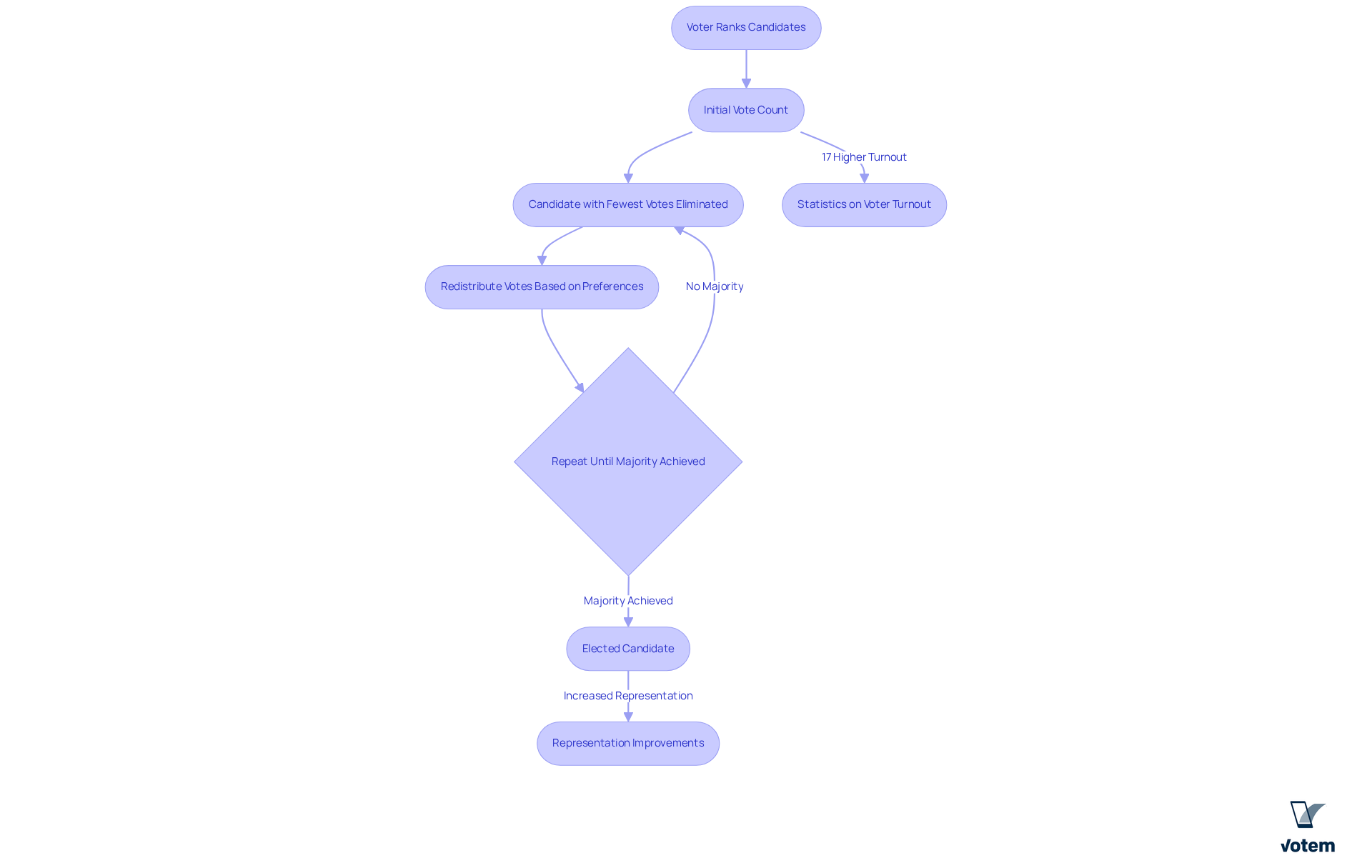
Trace the History and Evolution of Ranked Voting
The concept of prioritized balloting traces its roots back to the late 19th century, with its first applications emerging in Australia and the United States. This system gained traction as a direct response to the shortcomings of conventional plurality elections, which frequently lead to ‘spoiler’ candidates and unrepresentative outcomes, prompting discussions on what is rank voting.
Over the years, various prioritized selection methods have been adopted across different regions, notably the implementation of instant-runoff procedures in several U.S. states and municipalities. In the 21st century, there has been a notable resurgence of interest in preferential balloting, with many asking what is rank voting, driven by initiatives that advocate for electoral reform and aim to enhance voter participation.
For instance, the adoption of ranked choice elections in Maine and New York City exemplifies a growing recognition of the potential for prioritized balloting to elevate democratic engagement.
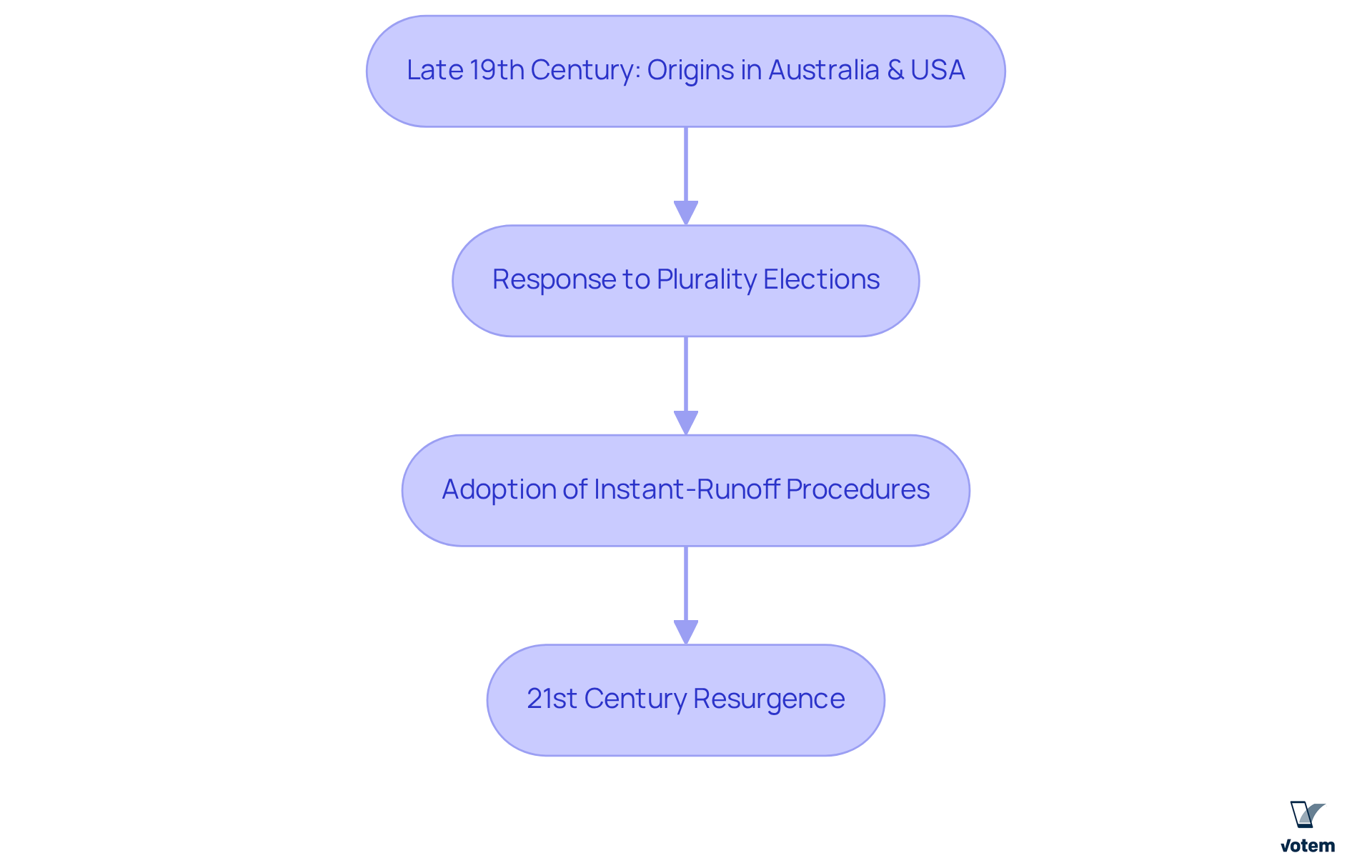
Examine the Benefits and Impact of Ranked Voting on Democracy
What is rank voting, and how does it offer significant advantages that can profoundly enhance democratic processes? By allowing individuals to prioritize options based on preference, this system alleviates concerns about wasting votes and demonstrates what is rank voting, thereby promoting greater involvement. Evidence of this can be seen in a 2024 survey where 86% of registered individuals emphasized the importance of majority support for winning nominees. Additionally, public awareness of ranked-choice voting (RCV) has risen from 56% in 2022 to 67% in 2024, indicating an increased familiarity with this reform and its potential to engage participants.
Furthermore, understanding what is rank voting fosters a more civil campaigning atmosphere; candidates are motivated to appeal to a broader audience in order to secure second and third-choice votes, which can lead to a decrease in negative campaigning. Research indicates that campaigns in regions utilizing preferential ballot systems are perceived as significantly less negative, with voters in these areas reporting a more optimistic electoral environment. As Todd Donovan, Ph.D., articulates, “participants, instead of simply winning or losing, you’re going to appeal to the backers of other participants to possibly rank you second, perhaps rank you third, so you don’t want to go negative as much.”
In addition, understanding what is rank voting can enhance representation by providing opportunities for individuals from underrepresented groups. For instance, in Minneapolis, the number of candidates nearly doubled following the implementation of this system. Notably, RCV is associated with a nine-point increase in the representation of individuals from racial or ethnic minority groups. However, it is crucial to acknowledge potential complexities, such as ballot exhaustion, which occurs when voters rank candidates but all their choices are eliminated, rendering their votes ineffective.
Overall, understanding what is rank voting has the potential to cultivate a more inclusive and representative electoral landscape, thereby strengthening trust in democratic institutions.
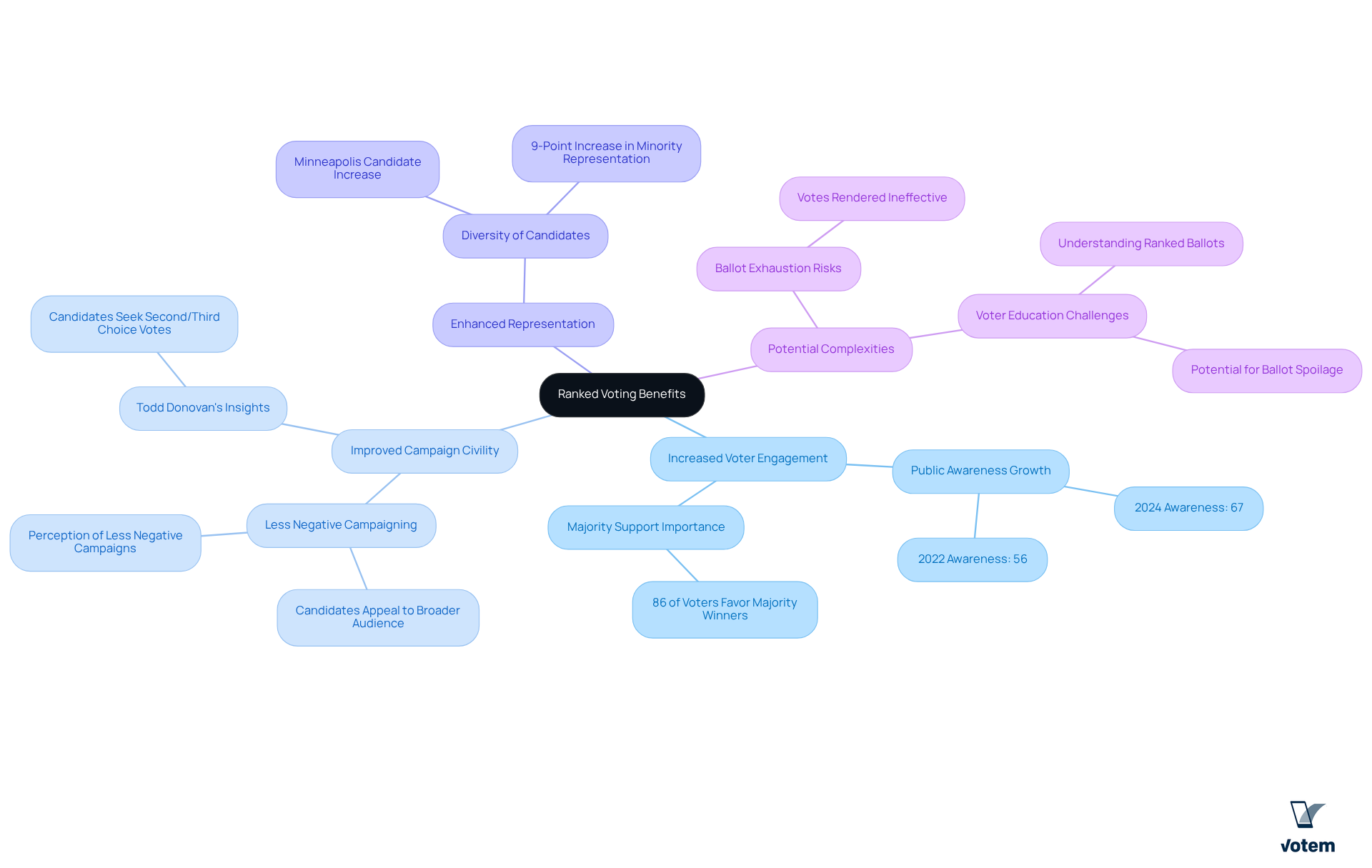
Challenges and Criticisms of Ranked Voting
What is rank voting? Ranked selection offers potential advantages; however, it faces significant obstacles that can undermine its effectiveness. Critics point out that the complexity of evaluating candidates may confuse participants, particularly those unfamiliar with what is rank voting as a selection method. Such confusion can lead to ballot errors, potentially disenfranchising voters and diminishing their engagement in the electoral process. For example, in Maine, the first state to implement choice-based elections statewide, many voters expressed uncertainty about how to rank candidates appropriately, resulting in an increased number of invalid ballots. This situation highlights the urgent need for clearer communication and voter education initiatives to ensure that individuals comprehend what is rank voting and can participate effectively.
Furthermore, concerns about strategic voting emerge within ranked choice systems. Voters might feel pressured to rank candidates in a way that does not genuinely represent their preferences, aiming instead to sway the outcome in favor of a more viable candidate. This behavior distorts the democratic process, shifting focus from authentic electoral intent to tactical maneuvering.
The implementation of tiered balloting raises important considerations about what is rank voting, necessitating substantial adjustments to electoral infrastructure and demanding robust voter education programs. These logistical challenges can strain resources and complicate the transition to a new electoral system. For instance, New York City experienced significant delays in ballot counting due to the complexities of preference-based elections, leading to public frustration and skepticism regarding its viability in large urban areas. Additionally, recent electoral setbacks, such as the rejection of preferential choice initiatives in seven states during the 2024 elections, underscore the broader challenges confronting this electoral method and reflect public sentiment.
Addressing these criticisms is vital to ensure that ordered selection systems, particularly what is rank voting, are not only effective but also equitable. As electoral experts assert, a well-funded and clearly articulated implementation strategy is essential to alleviate confusion and bolster voter confidence in the system. Sam Oliker-Friedland, executive director of the Institute for Responsive Government, notes that any state adopting preference-based elections must establish a well-funded, well-designed system backed by election administrators. Without such measures, the potential benefits of ranked voting may be eclipsed by its inherent challenges.
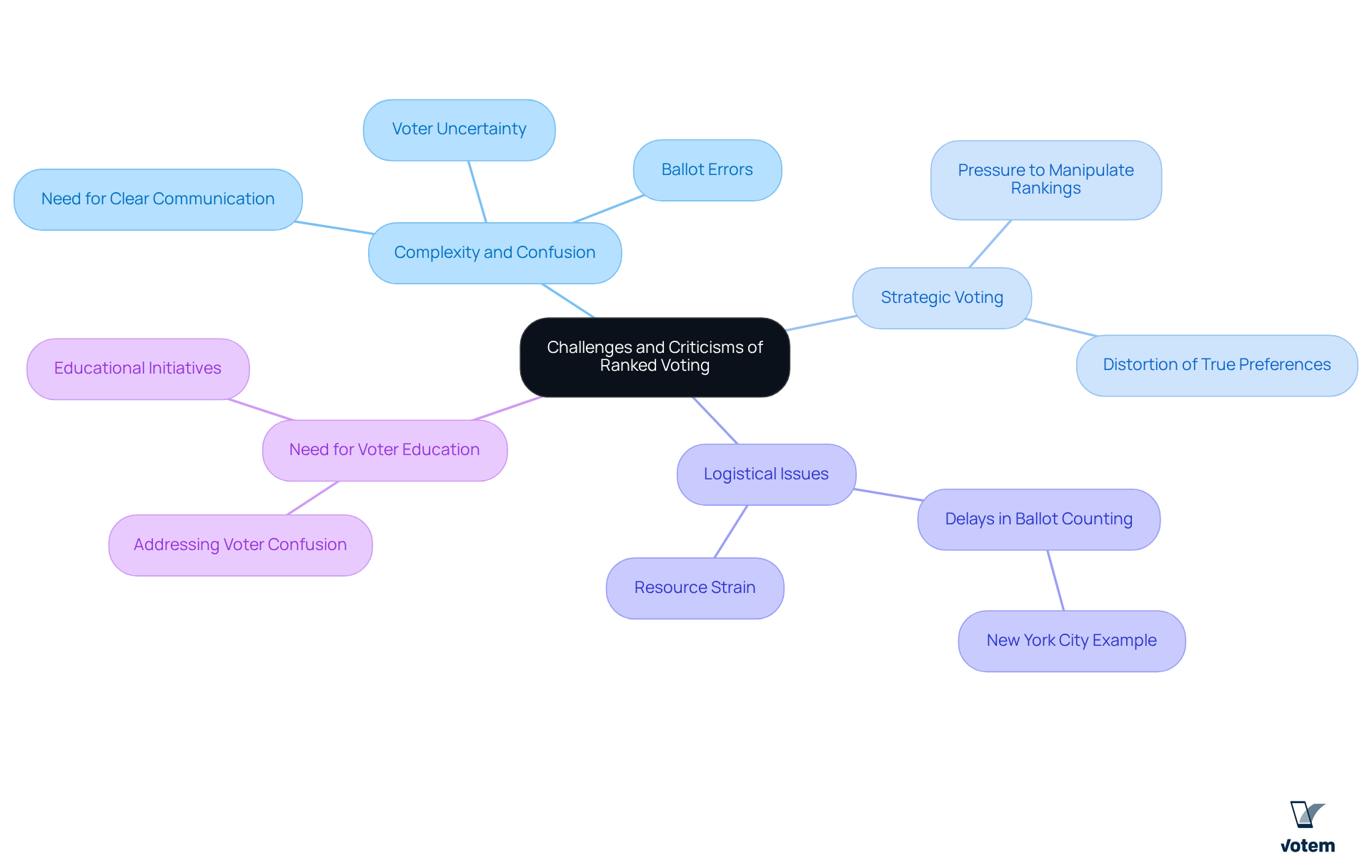
Conclusion
Ranked voting, or ranked choice voting (RCV), signifies a pivotal transformation in electoral processes, empowering voters to articulate their preferences with greater nuance. By allowing individuals to rank candidates instead of merely selecting one, this system endeavors to cultivate a more representative and engaging electoral landscape that mirrors a broader consensus among the electorate.
Key insights into ranked voting reveal its potential to enhance voter participation, promote civil campaigning, and elevate representation for marginalized groups. Notable examples from cities such as New York and Minneapolis illustrate how RCV can drive higher voter turnout and foster a more diverse candidate pool. However, challenges like voter confusion and the complexities of implementation underscore the necessity of robust educational and support systems to ensure its effectiveness.
Ultimately, the exploration of ranked voting highlights its capacity to nurture a more inclusive democracy. As interest in electoral reform intensifies, it is imperative for stakeholders to advocate for clear communication and comprehensive educational initiatives. By embracing ranked choice voting, societies can strive towards a more equitable electoral landscape that empowers every voter and fortifies the foundations of democratic engagement.
Frequently Asked Questions
What is ranked voting, also known as ranked choice voting (RCV)?
Ranked voting, or ranked choice voting (RCV), is an electoral system that allows voters to rank their preferences for candidates rather than selecting just one. This system enables voters to express a broader range of preferences, including primary, secondary, and additional options up to a specified number of candidates.
How does the counting process work in ranked choice voting?
In ranked choice voting, the counting process begins with the elimination of the candidate with the fewest votes. The votes of the eliminated candidate are then redistributed to the remaining candidates based on the preferences indicated by voters. This elimination and redistribution continue until a candidate achieves a majority of votes, ensuring that the elected representative has broader support among the electorate.
What impact does ranked choice voting have on voter participation?
Research indicates that ranked choice voting can significantly enhance voter participation and turnout. Cities that have adopted RCV have seen notable increases in participation rates, with studies showing that voters in RCV jurisdictions are 17% more likely to engage in municipal elections compared to those in non-RCV areas.
What are the benefits of ranked choice voting according to its proponents?
Proponents of ranked choice voting argue that it promotes diverse candidate representation and fosters a more civil campaign atmosphere, as candidates are incentivized to appeal to a wider audience.
Can you provide examples of ranked choice voting in action?
Notable examples of ranked choice voting include the 2021 New York City primaries, which achieved the highest voter turnout in over thirty years, and the Minneapolis-St. Paul area, where RCV implementation resulted in a 10% increase in voter participation, particularly in precincts with higher poverty rates.
How does ranked choice voting support representation for people of color?
Proportional ranked choice voting has a low electoral threshold that facilitates better representation for people of color, aligning their representation more closely with their population share. This aspect reinforces the importance of diversity in RCV elections.
List of Sources
- Define Ranked Voting: Mechanisms and Principles
- Does ranked choice Voting Increase voter turnout and mobilization? (https://sciencedirect.com/science/article/pii/S026137942400074X)
- Research and data on RCV in practice – FairVote (https://fairvote.org/resources/data-on-rcv)
- Examine the Benefits and Impact of Ranked Voting on Democracy
- Ranked choice voting – SciLine (https://sciline.org/elections/ranked-choice-voting-quotes)
- What We Know About Ranked Choice Voting, Updated for 2025 (https://americanbar.org/groups/public_interest/election_law/american-democracy/our-work/what-we-know-about-ranked-choice-voting-2025)
- Challenges and Criticisms of Ranked Voting
- Ballot measures to upend state election systems failed across the country (https://npr.org/2024/11/08/nx-s1-5183210/nonpartisan-primary-ranked-choice-voting-results)
- Ranked choice voting faces cloudy future after election setbacks • Stateline (https://stateline.org/2024/11/14/ranked-choice-voting-faces-cloudy-future-after-election-setbacks)
- STATEMENT: Voters Reject Ranked Choice Voting (RCV) in Seven States, Protect RCV in Alaska – Institute for Responsive Government (https://responsivegov.org/statement-voters-reject-ranked-choice-voting-rcv-in-seven-states-protect-rcv-in-alaska)

